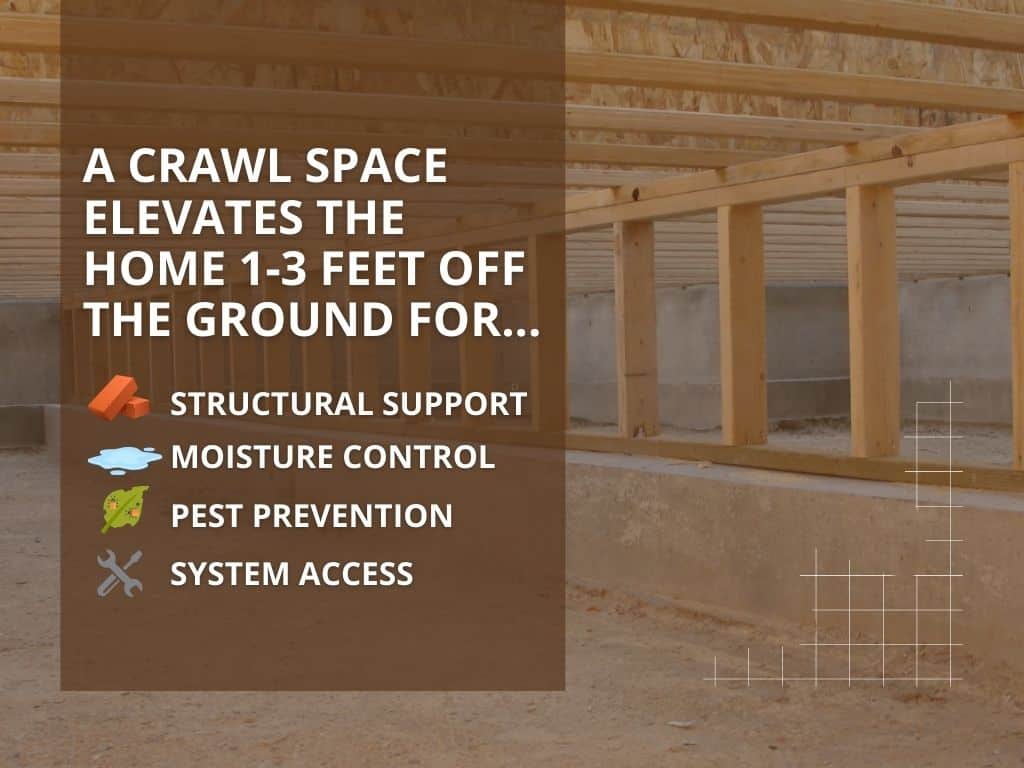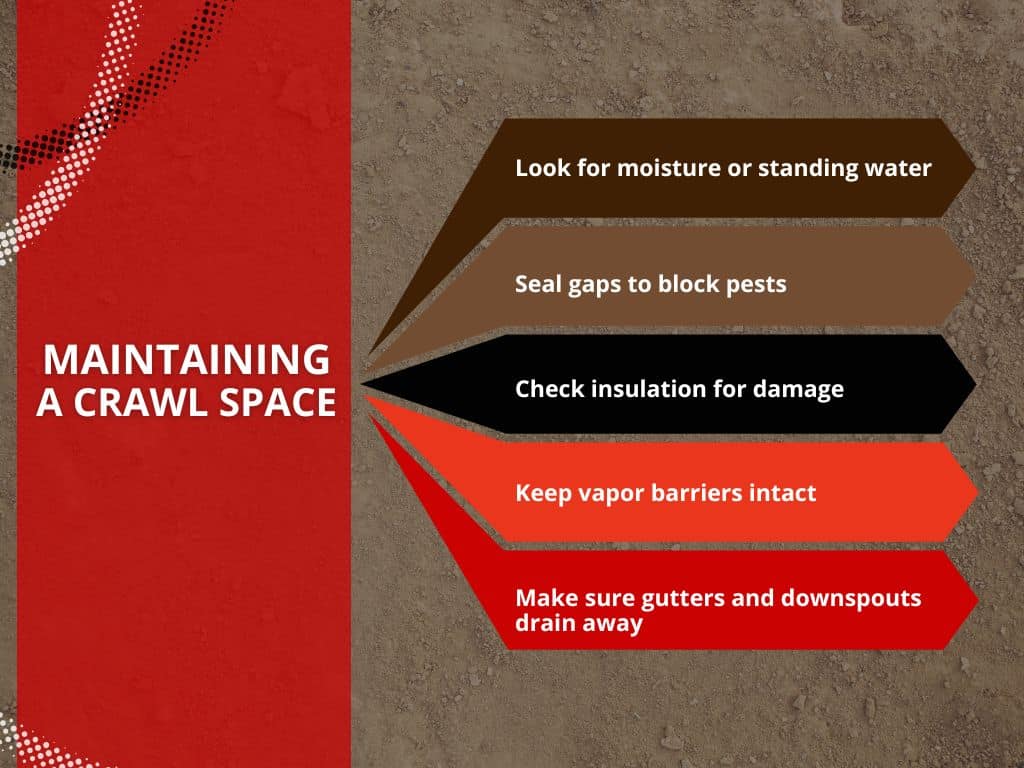Positioned between the ground and the first floor, your home’s crawlspace serves as a buffer zone that can help with moisture control, provide access to utilities, and protect the home’s structure. Yet, when neglected, they can invite moisture issues, pests, and even structural damage.
In this guide, you’ll learn its purpose, common issues to watch for, practical maintenance tips, and when it’s best to call in a professional.
Crawl Spaces Explained
A crawl space is a narrow, unfinished space beneath a home that allows access to plumbing, electrical, and HVAC systems. Typically between 1 to 3 feet high, it’s designed to elevate the home off the ground, helping protect it from moisture and pests.
Homes have crawl spaces instead of basements or slabs for various reasons. Some are built on uneven terrain where a slab isn’t practical, while others may choose a crawl space for easier access to essential systems.
Crawl spaces can also be a cost-effective option compared to building a full basement. There are three common types of crawl spaces:
- Vented: Designed to allow airflow to reduce moisture buildup but can also let in pests and humidity.
- Unvented: Sealed to control moisture but requires careful maintenance to avoid trapped humidity.
- Encapsulated: Completely sealed and lined with a vapor barrier for the highest level of moisture and pest control.
Why They Matter for Home Health
Crawl spaces serve several important purposes that directly impact your home’s health and comfort:
- Access to Systems: Plumbing, wiring, and HVAC components often run through crawl spaces, making repairs and maintenance easier.
- Moisture Control: A well-maintained crawl space can help manage moisture and prevent water damage.
- Structural Support: Crawl spaces help elevate and support the home, reducing the risk of ground-level moisture problems.

However, neglecting crawl space maintenance can lead to serious issues. Excess moisture can damage wooden beams, lead to mold growth, and lower indoor air quality.
Pests may find their way in, creating nests and causing further damage. Over time, these problems can impact the entire home.
Signs of Crawl Space Trouble
Catching crawlspace issues early can save time, stress, and repair costs. Keep an eye out for these common warning signs:
- Excess Moisture: Standing water, damp insulation, or visible condensation.
- Mold or Mildew: Musty odors or visible growth on surfaces.
- Pest Activity: Droppings, nests, or chewed materials like wood and insulation.
- Insulation Problems: Missing, damaged, or waterlogged insulation that affects energy efficiency.
- Sagging Floors: Uneven or soft floors above the crawlspace, indicating structural stress.
Simple Tips to Maintain the Crawlspace
Consistent maintenance helps keep your crawl space dry, secure, and problem-free. Here are straightforward tips to consider:
- Check for Moisture: Look for leaks, standing water, or dampness after heavy rain. Address any issues promptly.
- Inspect for Pests: Seal gaps and cracks that could invite rodents or insects. Check for droppings or signs of nesting.
- Evaluate Insulation: Ensure insulation is dry, intact, and properly positioned to support energy efficiency.
- Maintain Vapor Barriers: If encapsulated, check that vapor barriers are secure and free of damage.
- Keep It Clear: Remove debris, wood, or anything that could trap moisture or attract pests.
- Schedule Inspections: Professional inspections can catch hidden problems early and recommend long-term solutions.

Other Ways to Protect Your Home’s Structure
Beyond direct crawlspace maintenance, taking additional steps can support the health of your home’s structure:
- Improve Drainage: Ensure gutters are clear and downspouts direct water away from the foundation.
- Use Landscaping: Grade soil to slope away from the home, preventing water from pooling near the crawlspace.
- Consider a Sump Pump: If water buildup is a concern, a sump pump can help keep the space dry.
- Control Humidity: Installing a dehumidifier can help reduce excess moisture, especially in humid climates.
- Seal Vents and Openings: Close or cover openings where pests can enter while maintaining necessary ventilation.
When Professional Help is the Best Option
While routine maintenance can prevent many issues, some situations require professional expertise. Contact a professional if you notice:
- Persistent moisture or standing water that doesn’t resolve.
- Visible mold growth that spreads or recurs.
- Structural concerns like sagging floors, cracked beams, or rotting supports.
- Signs of severe pest infestations that are difficult to control.
- Uncertainty about whether encapsulation is needed or properly installed.
Professionals can diagnose issues, recommend lasting solutions, and provide peace of mind that your home is protected.
Conclusion
A healthy crawl space is essential for a strong, stable, and comfortable home. With regular inspections, simple maintenance, and the right professional help when needed, you can protect your home from moisture damage, pests, and structural problems.
If you’re unsure about your crawl space, basement, or foundation’s condition and need help, call Buckeye Basement Solutions in Columbus, OH for thorough inspections and customized solutions.



